
I have been putting off writing about Tokyo because there is just too much information to sift through, so many stories to write about and since I want to publish this post before I die, now would be a good time to start writing this blog (Or perhaps in 15 minutes….this blog post is reaaaaaaally interfering with my procrastination)!
Usually when I have too much to do, my brain (the chunk responsible for writing this post) walks out on me like “Yeah! I am done here!! Peace out!” (and I suspect it hasn’t yet returned!) After many hours of staring at my laptop screen followed by staring blankly outside my window [insert melancholy music], I finally decided brain or no brain, this blog post gets written today! [SCREW YOU brain!]
I should probably break this blog into two parts but I am lazy and I will just have to tell you when part two starts, and you can walk away and come back tomorrow if reading too much bothers you. (Also I just made this longer by adding this…)
So let’s begin…! Tokyo is a world unto itself! It is electric, colourful, full of culture, perplexing and alluring at the same time! There is also no such thing as a bad restaurant in Tokyo! The Japanese people are some of the kindest and nicest people Rajesh and I have met! The city is also unbelievably clean that you could almost eat off the street! (Although, you shouldn’t need to! There are plenty of options here and you can read about it here! )
How many days to spend in Tokyo?
Rajesh and I were blown away by the enormity of this city and we would recommend spending at least 4-6 days in Tokyo, so you don’t feel rushed and are able to take day trips from Tokyo as well.
Best time to visit
The weather in Tokyo is more or less temperate all year round but the best time to visit is during the fall (late September to November) or Spring(March – May). Japan, however, is a country affected by typhoons especially between August to September. When Rajesh and I visited in October of 2019, we were lucky to have just missed the Super Typhoon Hagibis and it did not impact our holiday! However, we did have travel insurance and we highly recommend you purchase a good travel insurance before you travel to Japan since Japan is susceptible to natural disasters such as earthquakes, typhoons and landslides.
Things you need to know before visiting Tokyo:
- Fly into Haneda airport if you can, it is much closer to downtown Tokyo. It is just a 15 minute train ride to the city center. Narita on the other hand is far from the heart of Tokyo. Like.Really.Really.Far.
- Get a JR Rail Pass if you are travelling outside of Tokyo. I know, I know, I promised to write a blog post about the JR, but as you know I am very lazy (Sometimes I sleep on top of the covers just so that I don’t have to make the bed, that’s how lazy I am! Who makes their bed anyway? Ain’t nobody got time for that! If you make your bed then how will you lay comfortably on a lump of blankets when you are hiding from adult responsibilities???!!). Also as the readers of my blog, this should come as no surprise that I am less of a do-er and more of a forever-slumped-on-the-couch-er, I throw out the idea of doing anything productive by watching unhealthy amounts of TV. (YOLO!)
Anyway, even if you are travelling from Tokyo to Kyoto and back, the pass can work out cheaper. To get a rough idea on how much it would cost you to pay for your tickets on the go instead of getting a JR pass, you can use: https://www.japan-guide.com/railpass/ and allow me to be lazy! Rajesh and I bought the 14 day JR pass since we spent a lot of time outside of Tokyo. You will have to pre-order them (from a JR Rail Pass vendor) before you get to Japan as these cannot be purchased in Japan itself. You will get an exchange order that you must exchange for the pass when you arrive in Japan. There is an exchange office at the Haneda Airport itself which is open from 6:45 AM to 6:30 PM, so you can collect your JR as soon as you land. Also, the exchange order must be exchanged within three months, so don’t order too far in advance! You can use HyperDia [https://www.hyperdia.com/] to get information about train routes, timetables and even platforms. - Cover up your tattoo’s: In Japan tattoos are closely associated with the Japanese organised crime syndicates, the yakuza. I covered up my tattoo with a sticking plaster for most of my trip. In fact people with uncovered tattoos might not be allowed to go to the onsen, sento or even some ryokans!
- Carry your trash with you: One of the first things that Rajesh and I noticed was how clean Japan was even though there were so few garbage bins! We went on an expedition to search for a trash can and after wandering around for what seemed like eternity, we managed to locate ONE trash can! I was so happy, I might even have wept a little [more like a river of happy tears], most of which I sloppily wiped onto the clavicular region of Rajeshs’ shirts! So we’d advise you to always carry a sealable zip-loc bag, so you can put your trash in it until you find some place to dispense it like a convenience store or back at your hotel room. Else you will end up like me (not necessarily a bad thing), I usually put away candy wrappers in my pocket, telling myself that I’ll throw them away later. And almost always the trash comes out of my laundry washed and clean!

- Don’t eat while walking: The Japanese tend to not eat while walking or standing around on the street. It is actually frowned upon. Although drinking next to a vending machine is acceptable. That’s probably another reason the Japanese do not have problems with trash because they eat their snack right where they get it, then throw away their trash there rather than carry it around with them.
- Don’t tip: In restaurants, taxis, and other places I can’t think of right now, tipping is not customary. It is not part of Japanese culture. The Japanese believe that good service should be the standard and therefore there is no need to pay extra. If you try to tip someone they may politely refuse it or even get confused by your action. The price you see is the price you pay. Novel idea, I know.
- Onsen Etiquettes: You can read about it in my previous blog
- Convenience stores are a thing in Japan! A great thing! : You can’t go a block in Japan without passing at least one convenience store! In fact Japan has the most number of 7/11’s in the world! (Yes! Being my friend means unknowingly subscribing to a lifetime of random facts that you may or may not care about!). Japanese convenience stores (Konbini) are soooo……CONVENIENT! They are unlike any convenience store we have ever been to! Especially if you are craving something cheap at 2 AM, you can head to one of the convenient stores in Japan! They even have hot food like steamed buns and croquettes and you can even get a bento box, soba noodles, dorayaki or a melonpan! THEY HAVE IT ALL!! They are all great options!! (Maybe not from a health standpoint, but surely some other one!). And all of their snacks look soooo cuteeeeee!!!! I usually don’t pick my food based on its cuteness…if I did I would probably be snacking on Alpaca’s and Japanese babies! But these cute snacks were just calling out to me!! My instincts told me : “You must eat all these cute snacks and if you don’t your life won’t be complete, seriously, move faster, why aren’t you moving faster???? JEEZUS woman! ”. Apart from the great selection of condiments, they also have an ATM and other services such as ticket reservations, printing, bill payments etc etc. So make sure you visit the convenience stores…THEY ARE GREAT, JAPANESE CONVENIENCE STORES ARE EVERYTHING YOU EVER DREAMED OF, THEY ARE ……… what??!!?……. Nothing is wrong with me………. uhem *tries to look cool*…just sayin that Japanese convenience stores are awesome and we love them dearly
- Japan is also the undisputed home of the vending machine, there is literally a vending machine for everything! Need a coffee? Get a coffee shot from the vending machine. Craving a banana or a fish? the vending machine has got you covered. Want a bottle of wine, yup yup you can find it here! Need a new pair of underwear, look no further, there is even a vending machine for that!


- Have cash on you: Japan is making slow movements to a cash free society, but most souvenir shops, vending machines accept cash only. Even in big cities like Tokyo, some restaurants and bars only accept cash!
- Learn a little Japanese: Politeness is a large part of Japanese culture and showing even a little effort to learn Japanese will be greatly appreciated by anyone you meet.
Here are a few basic Japanese words and phrases that we remember:
Hello – Konnichiwa
GoodBye – Sayonara
Thank you – Arigato gozaimas
Excuse Me – Sumimasen
Yes – Hai
No – iie
Also have google translate on your phone! Some restaurants did not have an english menu and google translate was a life saver! Rajesh kept saying `Arigato Gozaimas` to cashiers at the grocery store and that would have been NOT WEIRD if we weren’t in Australia (but somewhere else…like Japan!). Whatever inexplicable level of weirdness Rajesh produces, puts me at ease because it makes me look less weird in comparison!! [hah! Also I’m cool!! ✌🏼 ]
- Be blown away by the greatest Japanese invention – The Japanese toilet: IMHO, It is the Starbucks of toilets! I don’t want a new house or a new car BUT I GOTTA HAVE ONE OF THOSE FANCY JAPANESE TOILETS PLEASE!!
What’s so great about Japanese toilets you ask??
That’s a great question! And I have a great answer. Come this way, my dear friend! When I first saw the Japanese toilet, with its multitude of buttons, I was as confused as Mr Muppet below!
But when in doubt, press all the buttons! This amazing robot toilet – your new best friend, closes and opens the seat automatically for you, warms up the seat to your desired temperature, he even have a special antibacterial coating and both rear cleansing and drying functions – never again do you have to waste millions of layers of toilet paper, you can even adjust the water temperature and pressure! Like that is not enough, he even sings to you – plays music of your choice so you can discreetly do your business! He is even equipped with a deodorizer!
After experiencing what it feels like to have your butt treated like a god, it is very very hard to go back to your old peasant ways! I absolutely regret having spent all these years in darkness without my friend, the Japanese toilet!


Are you still reading? YOU CAN’T SMEAR CHEESE ON YOUR NEIGHBOURS CAT BECAUSE THE ALPACAS ARE GROWING TENTACLES OF WISDOM TO OVERTHROW THE GOVERNMENT!! Just checking….
Itinerary:
Day 1: Explore Asakusa & Sensoji
Day 2: Watch Sumo, explore Harajuku & Gado Shita
Day 3: Day trip to Nikko
Day 4: Explore Tokyo & Golden Gai
Day 5: TeamLab Borderless, Shibuya crossing, Akihabara & Piss Alley
Day 1: Explore Asakusa & Sensoji
Asakusa is a relatively older town which gives you a great opportunity to explore the more traditional side of Japan. Its most popular attraction is the Sensō-ji , an old Buddhist temple built in the 7th Century.
Sensō-ji

Rajesh and I dropped our luggage and walked to Sensō-ji, our hotel was a stone’s throw away from this temple. We first took a customary photo of the iconic enormous red lantern at the Kaminarimon Gate (also called the Thunder gate). A symbol of Asakusa.
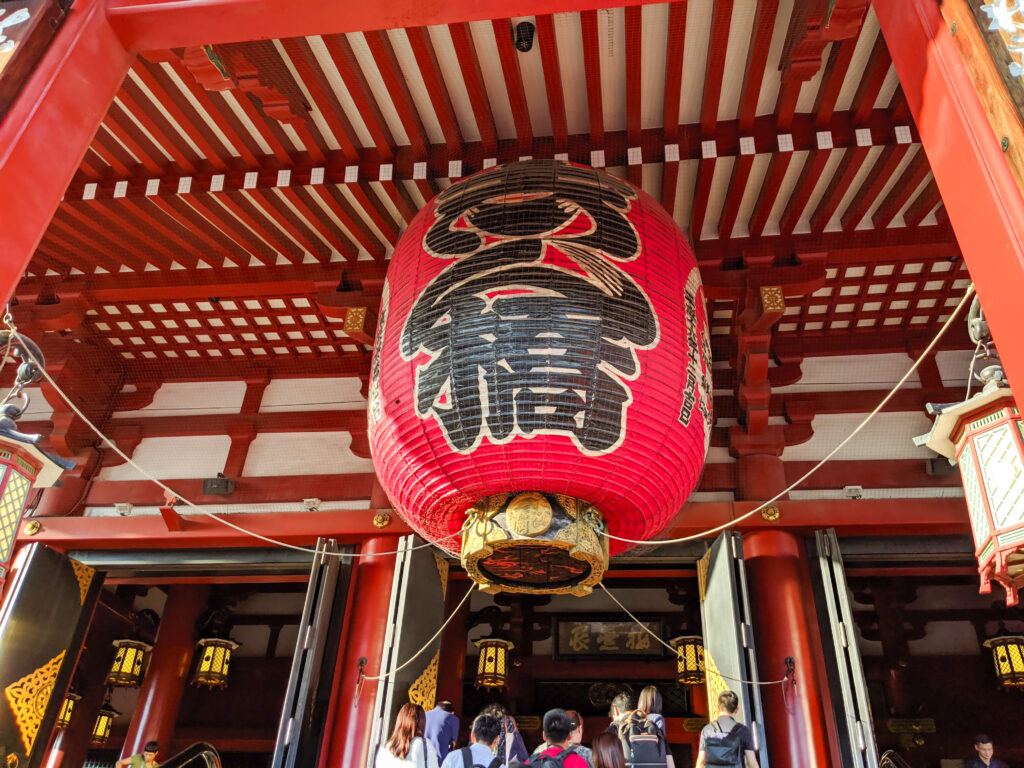

Sensō-ji is pretty crowded, and as you enter you will be engulfed by a blinding cloud of smoke from the large incense burner (also known as the Jokoro). You will notice visitors trying to cover themselves in this smoke. The smoke is believed to have healing properties and ward off illness. As you enter Sensō-ji, you will notice a small, stone fountains with ladles perched on top. These are called Chozuya / Temizuya, and people use them to wash themselves before entering the temple.


It can be quite crowded and swarming with tourists (especially during Sakura season). If you are curious to know what swimming in a human sea feels like, this place is for you [thrusts out thumb-up sign enthusiastically]. Just step into the sea of people and flow through the Nakamise dori that is lined with open-air shops and stalls selling souvenirs, and, more importantly, food! Food’s really what you want. So that was our plan: walk around and eat food.
Nakamise Dori
The Nakamise Dori is located on the passageway that leads up to the temple and feels like a good starting point to get your feet wet and explore Japanese food culture. You can also buy plenty of souvenirs here!



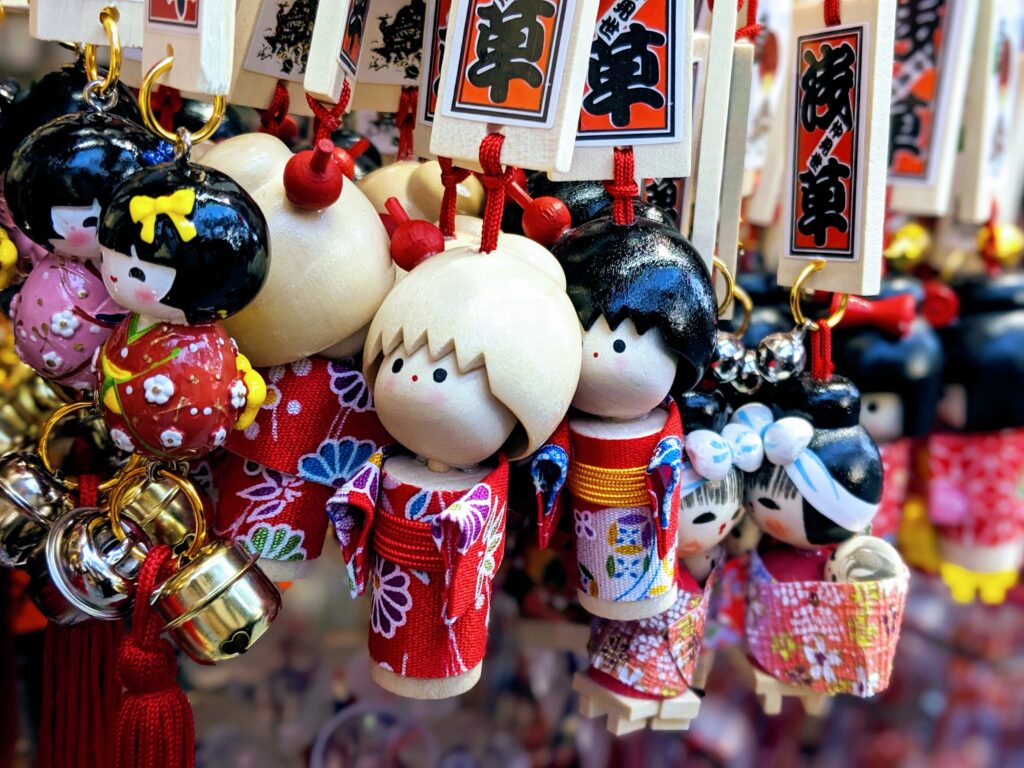
We spend most of our evening strolling around the city and sampling the local cuisine. And contrary to walking in India (particularly given the state of the pavements in my own country or the lack of it? In India, walking is for those with the mental makeup of Genghis Khan, people with an appetite for risk or those who enjoy extreme sports. Pavements are mostly for vehicles for driving on and occasionally used by pedestrians who enjoy being bumped in the back or having their toes run over!), walking in Japan is very very enjoyable. We also walked across the Sumida river and took some shots of the sky tree.
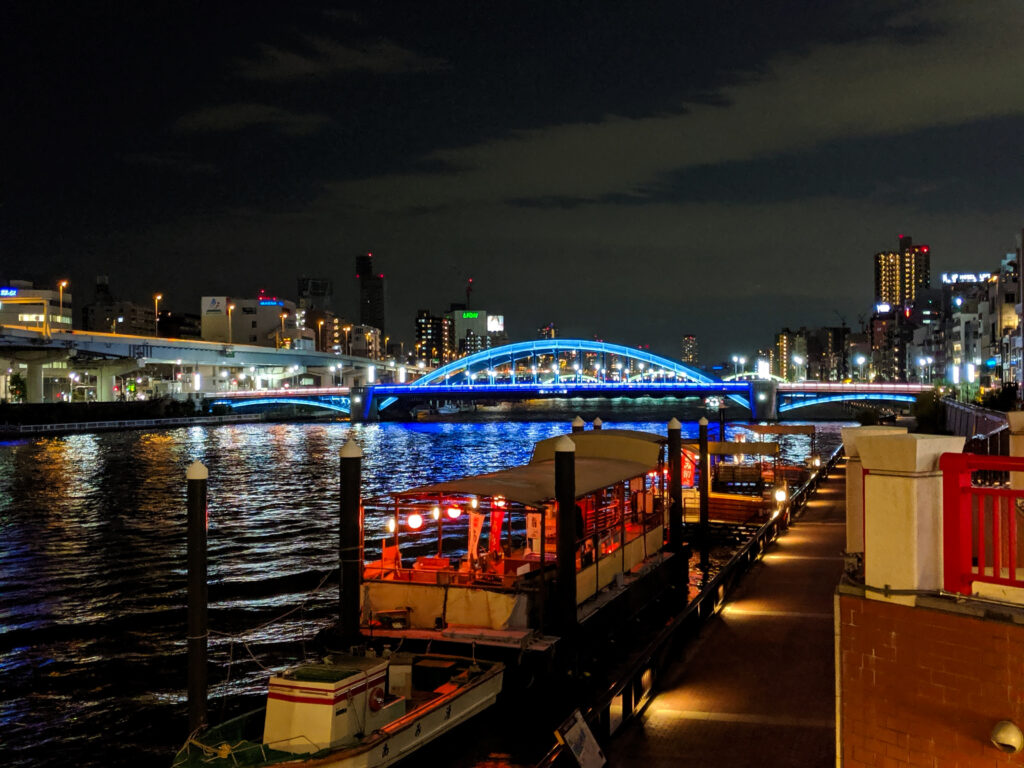
Hoppy Dori
Hoppy Dori (or Hoppy street) is one of Asakusa’s most famous location for eating, drinking and experiencing Tokyo’s downtown nightlife

It is lined with old-fashioned taverns on both sides and always looks like it has exceeded its legal capacity by about 200% (so expect it to be pretty crowded), the outdoor street seating gives the whole area a very festive vibe. At night, the lanterns adorning the front of the taverns create a charming retro atmosphere, making a stroll here the perfect night-time activity in Asakusa. Rajesh and I ate and drank some local Japanese beer here, as the drinks poured, inhibitions faded and conversations were made, of which I do not remember much about, except for there was a lot of hand gesturing and a lot of laughs.
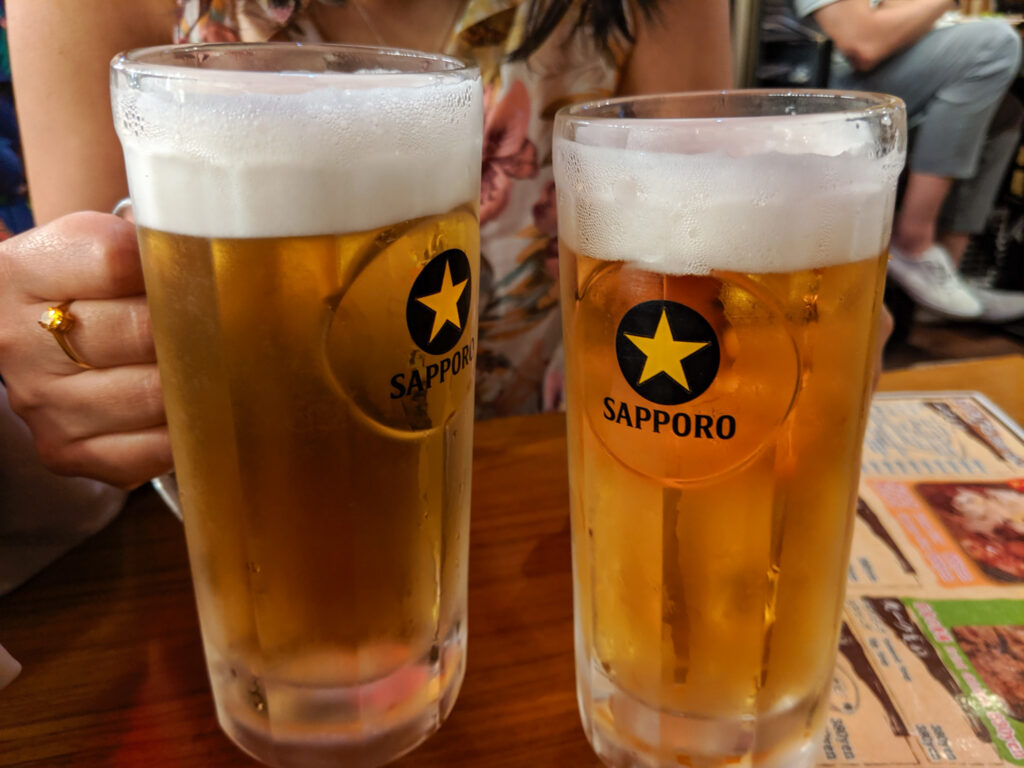
Day 2: Watch Sumo, explore Harajuku & Gado Shita
Sumo:
Sumo is quintessentially Japan, it is so synonymous with the country, it is difficult to imagine it existing elsewhere. It is also a unique national sport for a country that has a reputation of being understated and polite. It is a fascinating sport with an uncertain future. Due to the harsh lifestyle of a Sumo wrestler, it is difficult to hire new recruits and so I would urge anyone visiting Japan to go see some if they can. The lives of these wrestlers are strictly regimented and disciplined more than that of any other athletes in the world. Their life in the sumo beya or the stables where they live, train and sleep is extremely hierarchical where the lower ranked wrestlers are expected to cook, clean, and serve the higher ranked wrestlers. They also refrain from showing any emotion, be it happiness resulting from winning or disappointment at losing a tournament.
There are sumo matches that happen throughout the year (from January to November) and each tournament lasts for about 15 days. However if you do happen to miss these tournaments, you can also visit one of the sumo beyas where these wrestlers live and train, like we did. You have to wake up really early as these practice sessions happen to start as early as 5:30 AM.
We had our friendly hotel receptionist call the sumo beyas to check which ones would allow us to come visit after spending what seemed like eternity trying to explain to him what we wanted him to do for us (Google translate did come to the rescue!) I instantly regretted not learning some basic Japanese. I probably could have mastered the Japanese language in the time I spent scrolling on the internet (however, I am yet to test this theory!). Seriously folks, you could be watching funny cat videos for like a few seconds and barely notice that the earth has made one complete rotation. Sometimes I wonder if my finger has travelled more miles scrolling on my phone than my legs have walked on this earth.
We initially planned to visit Takasago Beya but since it was closed on the day, we decided to watch the practice sessions at Arashio Beya instead. We started out really early in the morning and I was surprised to see people out and about. Unless you are a Sumo wrestler, or a tourist going to watch a Sumo wrestler or sacrificing children to Satan during his holy hour, there is really no reason for you to be out of your bed so early in the morning! It also started to rain and made the commute all the more unpleasant for me. Usually rain is my best friend, it lets me get out of plans/not meet large groups of people/ not leave my couch/ get dressed etc etc…where can I vote for pajamas as fashion must-have timeless trend that will never ever die? But I absolutely hate when it rains when you are on a vacation. It was raining so hard, I am pretty sure you could take your fish out for a walk. Luckily I had packed away a plastic poncho, which looked like I was wearing a garbage bag. If you ever find yourself wondering how it would feel to be a plastic bag drifting through the wind or you want to look like a traffic cone, you should buy one of em plastic ponchos in a really bright color like I did! Once we reached the sumo beya, I was surprised to see how crowded it was. It was swarming with soaking wet tourists, and it was reassuring to know that Rajesh and I weren’t the only crazies in this world. Sumo wrestling was unlike anything we had ever seen, we learnt that the wrestlers go on a special diet of Chankonabe, which is a special type of stew served in a giant pot. They consume nearly 20,000 calories per day, 10 times more than a normally recommended calories for an adult male!

After watching sumo wrestlers practice, we headed out to Roppongi. The clouds had cleared up by then. Animal cafes are a rage in Japan, there are owl cafes, hedgehog cafes where you can sip on green tea and get up close with some adorable animals. As soon as we entered the cafe, we regretted it immediately, we had made a pre-booking but we decided to leave. If our travel experiences have taught us anything, it is that very few animal experiences around the world exhibit perfect ethics. It is unethical to keep these animals in glass boxes to be picked up and put down constantly by people, exposed to sunlight despite being nocturnal and solitary creatures. You could see that these tiny adorable creatures were agitated and scared. They even have a meerkat on a leash and it was just sad since we could see these animals were probably under a lot of stress. Japan, unfortunately, is one of the worst in the world when it comes to animal welfare, treating animals as accessories or a source of entertainment. If you can, please refrain from going to any of these animal cafes when you visit Japan.
Harajuku:
Instead where you should head to,is Harajuku, the birthplace of loud, eclectic, colourful styles of the Japanese youth. It is the Mecca of Kawaii culture. First we head to Takeshita street, a bright and colourful shopping jungle, the one stop-shop to experience Japanese pop culture.

You will experience a sensory overload from the fast food outlets selling candy floss and crepes! You MUST have one of the crepes here, the selection of crepes is soooooooooo sooooo large. Rajesh, after doing some intense mathematical calculation using Ham Sandwich theorem (which btw is a real thing and not something I just made up!! Seriously guys, I am NOT crazy!) announced that it would take us at least a month to try all of the flavours if we were to start that very second. GET TO WORK! (Although being the indecisive person that he is, I suspect it would take him a month to just pick one). A MONTH??? I was horrified! Maybe if you had 2 crepes everyday, I will have about 14, thank you!
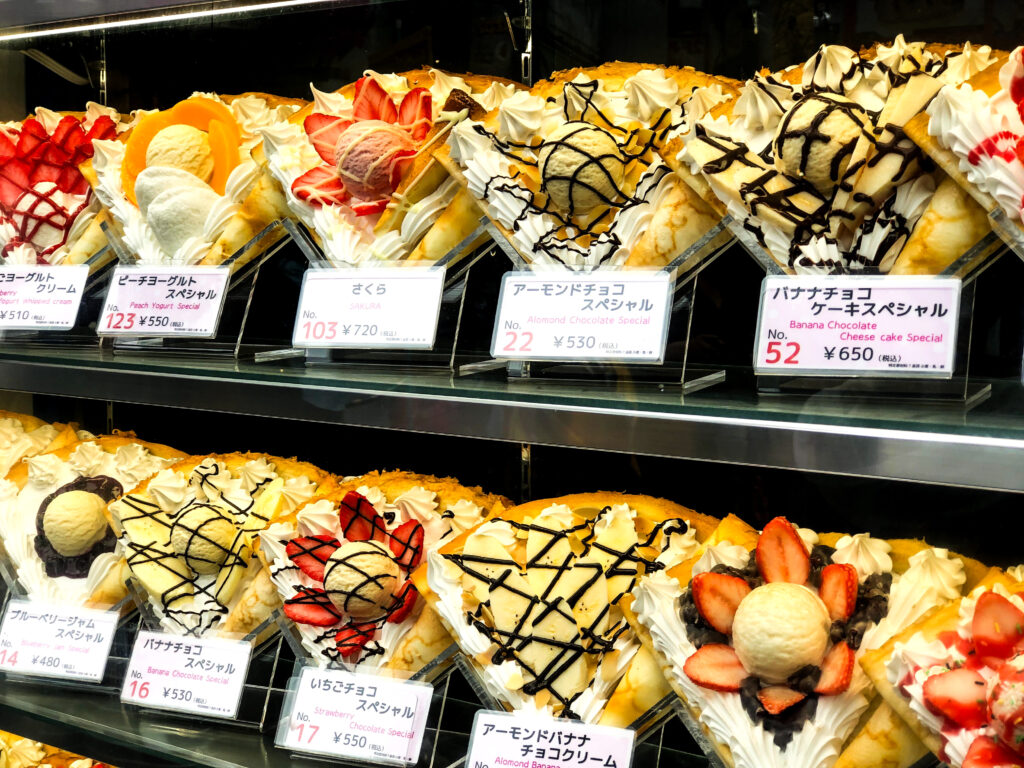


If you want to shop til you drop, make sure to check out Takeshita Street in Harajuku. It is lined with a plethora of shops selling everything from Gothic/Lolita to cute Kawaii clothes. The Lolita/Goth Lolita subculture in Japan can be traced back to a form of protest against the societal oppression faced by women. In a culture where young women were pressured to wed and bear children early, the Lolita style emerged as a way to reject conventional womanhood, symbolising a resistance to conforming to societal norms through its youthful and whimsical attire. You can also see young people cosplaying as familiar Anime characters here.

Another fun activity here (besides stuffing your face with crepes) is going to the Purikura Booth. These are Japanese photo booths that are incredibly popular among Japanese teenagers.
I would totally recommend it, firstly because who doesn’t like to look airbrushed, augmented and creepy-alien like in their pictures (or a demon from supernatural idk)! Secondly, it is amazing to see how seriously the locals take these photo shoots. They are dressed up in the coolest outfits and have their make up on point. There is even a makeup room here complete with curling irons and what not. Feel free to venture into these makeup rooms to experience what a backstage of a fashion show might feel like!
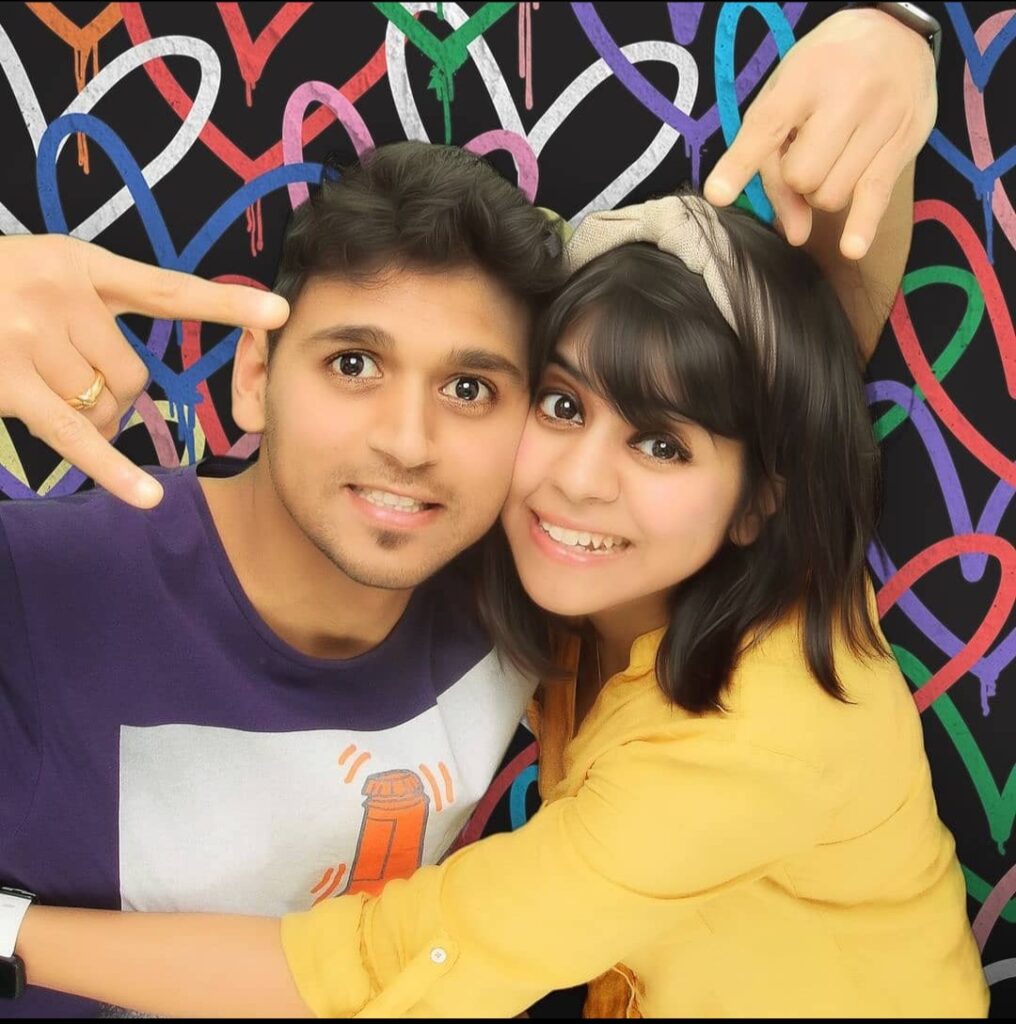
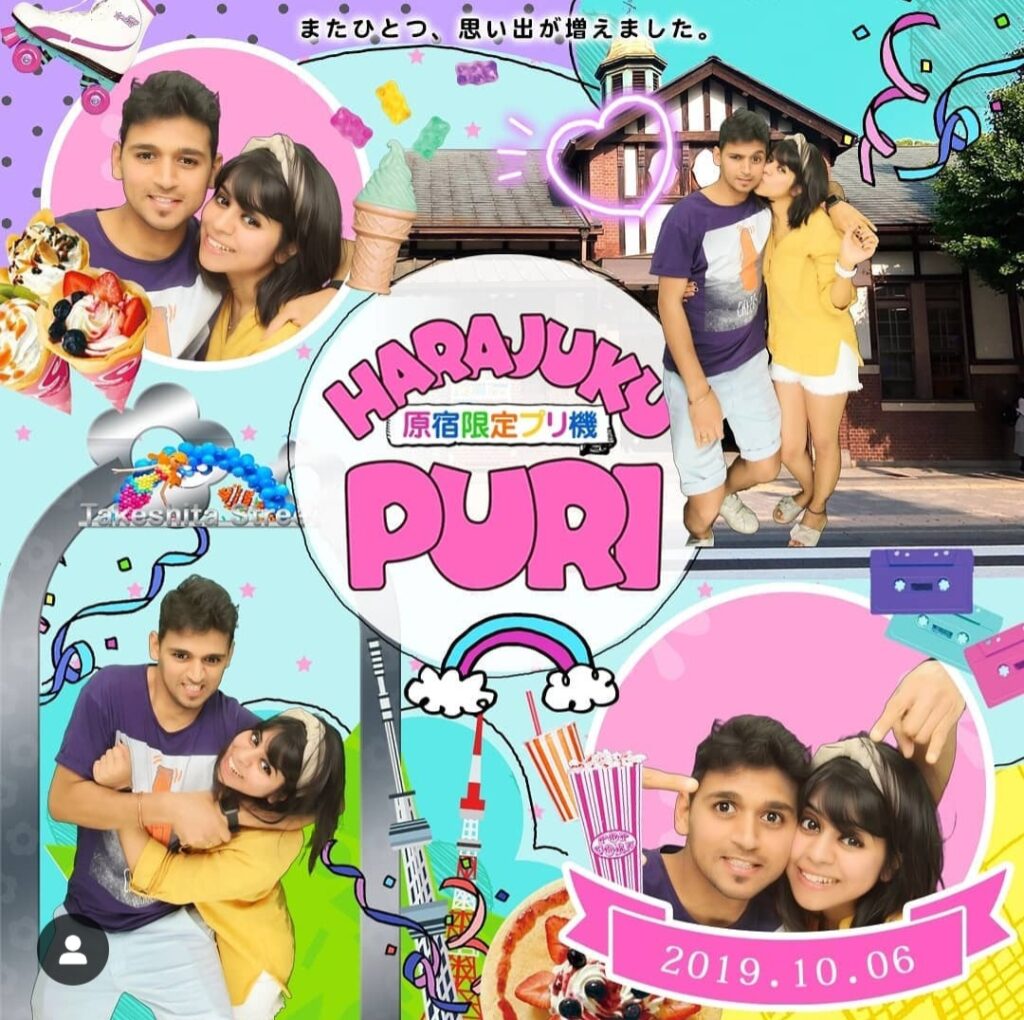

Tokyu Plaza Omotesando:
Another really fun thing to do in the area is head to the Tokyu Plaza Omotesando Harajuku. It has the most futuristic entrance, engulfed in a kaleidoscope of mirrors, also one of the most instagrammable spots! There is also a Starbucks on the top floor with a roof garden and a nice little spot to relax with a cuppa and a birds eye view of the city below!
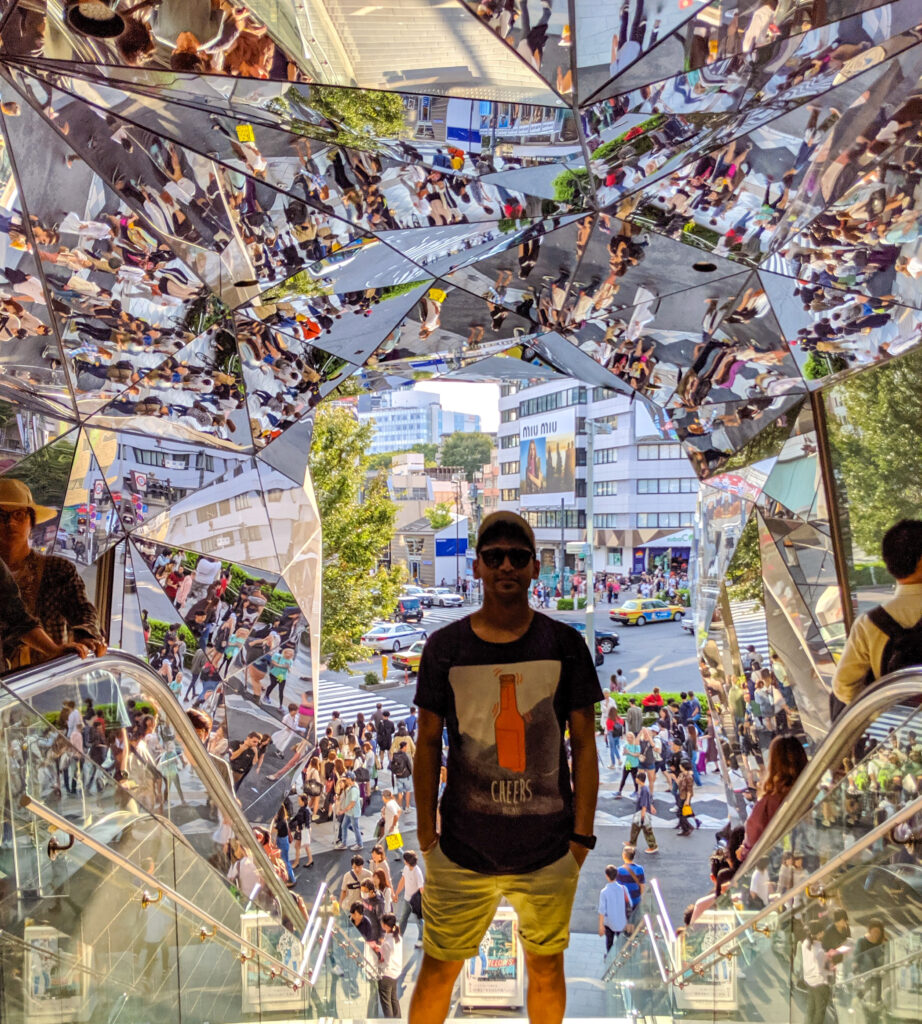

After spending a couple of hours in the area, we head to T tan tans (check my blog for more details) for dinner, we head out to find some izakayas (Japanese pubs) for a few drinks. We went to the Gado Shita (which literally means under the girders). These are restaurants and bars that are under the train tracks and some of them have been open since the 1950s! Something about the dark streets, mysterious people and shops smelling of grease and yakitori smoke and brightly colored signs is utterly beautiful to me. Both Rajesh and I just love the aesthetics of this city! The noise from the trains passing by above further adds to the charm.
We also remember being totally in awe of our bartender who was just about the right amount of friendly-and-chatty and made our wonderful drinks within an eyeshot! Being the right amount of chatty is soooooo important, because honestly guys, I am not so sure that saying “stop talking to me” is a very good social skill! Most often I’d just say something like “LOOK OVER THERE..A COW!” [points] and run away while you’re distracted. And I did not have to do that even once here (I give myself a mental gold star!)
Getting here is pretty easy too, just head to the Yurakucho district which lies one stop south of Tokyo Station along the JR Yamanote Line, the area is also accessible from Ginza station.

Day 3: Day trip to Nikko
If you love Japan, you will love it crapload more if you visit Nikko. Our day trip to Nikko was AWESOME (as you will soon see…if I can write fast enough), you MUST visit Nikko if you get the chance, it is an easy 2-hour train journey from Tokyo, home to a number of shrines that are also listed as World heritage Sites. Not only do you get to see some fabulous Japanese architecture but it is also home to many beautiful natural wonders and there are plenty of hiking trails in the area.
How to get to Nikko?
If you have a JR pass, you can take the JR Tohoku Shinkansen from Ueno Station to Utsunomiya and then transfer to the JR Nikko Line which will take you to the Nikko Station. The whole journey takes about 2 hours! There are also buses that go to Nikko from Tokyo Station which takes slightly longer.
Tips:
- Aim to reach Nikko early. We planned to arrive in Nikko around 9 AM so we had plenty of time to explore the place
- Carry food and snacks (Especially if you are a vegetarian), as there aren’t many eateries in Nikko and there is a lot of walking to do.
- Put on comfortable walking shoes, because there is a lot of walking involved. And it is quite enjoyable too (Yes yes, I admit I enjoyed something that involved physical exertion. This may never happen again)
What to do in Nikko?
Once you reach the Nikko Station, you can hop on a bus outside the station that will take you to the Shinkyo Bridge, this is your first stop in this itinerary!
Shinkyo Bridge:
It is the most photographed bridge in Japan and you can see why! This bridge has been a crossing to the temples and shrines since 1636 and belongs to the Futarasan Shrine. You can actually cross the bridge for an additional 300 JPY.
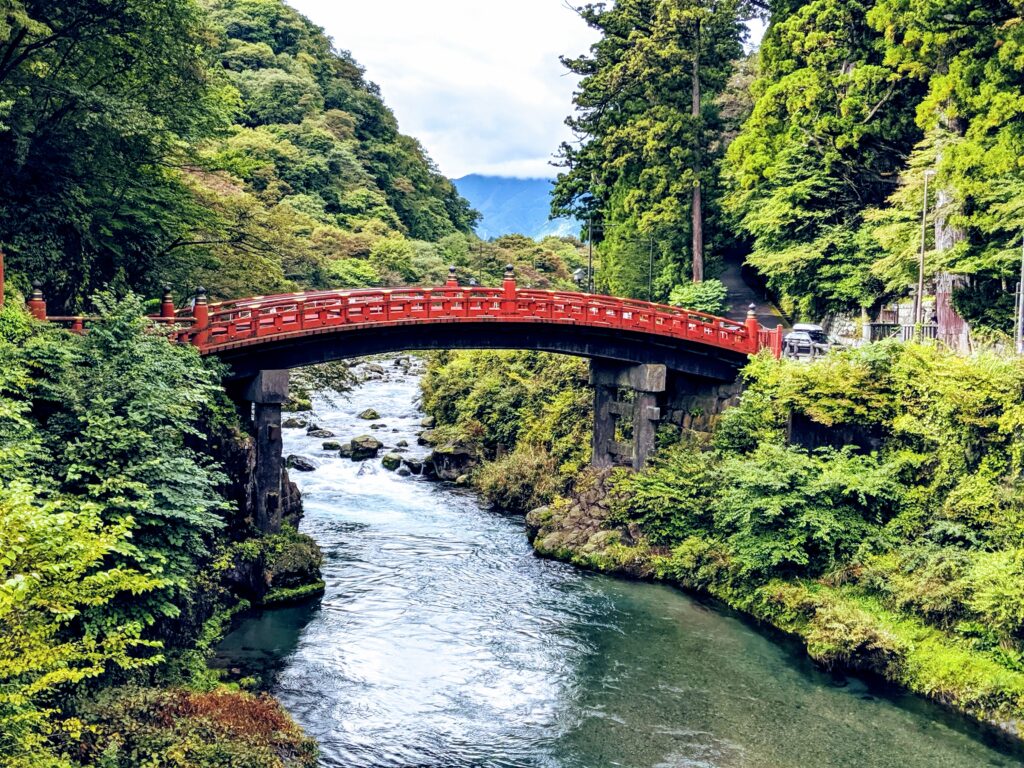

Rinno-ji Temple:
Rinno-ji is one reputedly known to be one of the most important temples of Nikko.
The history of Rinno-ji can be traced back to the 8th century, and was founded by the Buddhist high priest Shodo Shonin. After years of studying Nara Buddhism and going through several hardships, he had resolved to found a religious centre in Nikko. Photography is not permitted inside the main building, the Sanbutsudo.
Nikko Toshogu Shrine:
This is hands-down the best shrine in Nikko. Toshogu Shrine enshrines Tokugawa Ieyasu, who founded the Tokugawa Shogunate that ruled Japan for over 250 years until the Meiji Restoration in 1868. The entire complex is adorned with intricate wood carvings, gold leafs and vivid colours. The ticket office is just past the 5-storey pagoda to the left of the stairs leading up to the shrine. The pagoda is really really pretty but also really really crowded. It is almost impossible to get a picture without the people in the background, so I will just pretend they aren’t there.

One thing to look out for are the animals on the shrine. There is a sleeping cat, The three wise Monkeys, which are the basis for the “hear no evil, speak no evil, see no evil”, the oriental dragon on the ceiling somewhere, there is so much to see around here, IT WILL MAKE YOUR BRAIN EXPLODE! We also climbed 207 steps to the top where the inner shrine is located which is also Tokugawa Ieyasu’s mausoleum. I know 200 steps sounds intimidating, but I will have you know it wasn’t so bad at all, I only cried twice!
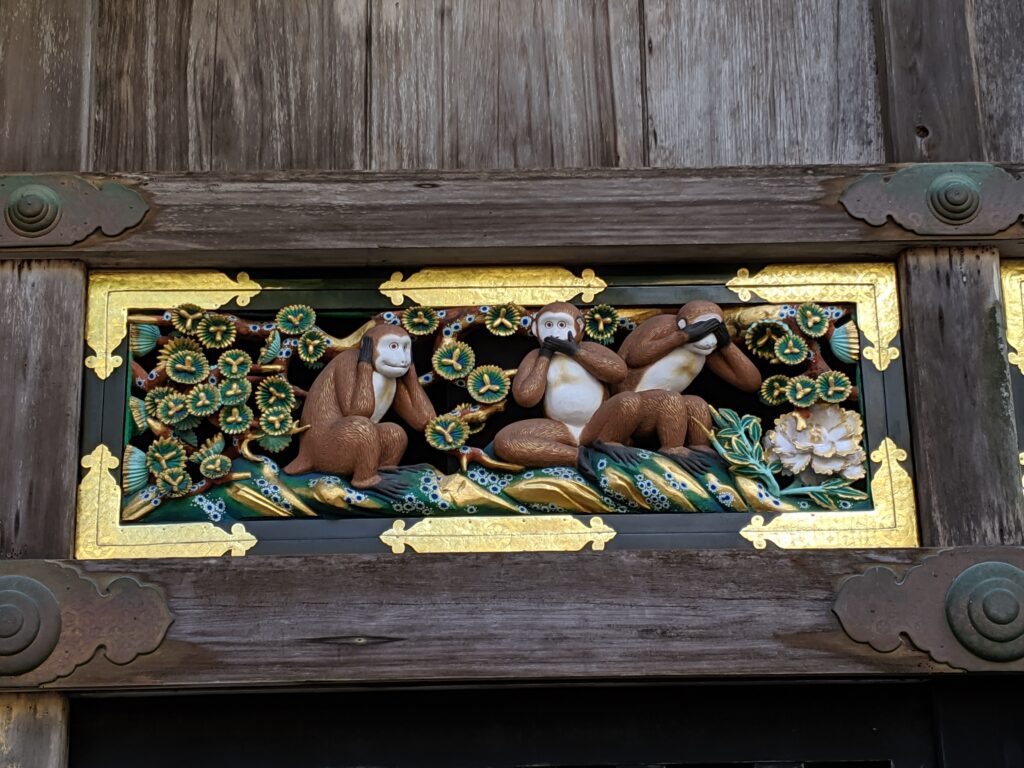

Nikko Futarasan Shrine
This shrine is dedicated to the deities of Mt. Nantai, Mt. Nyoho, and Mt. Taro, which are Nikko’s three most sacred mountains. Here, you can get an Omikuji (basically these are random fortunes written on strips of paper). When the prediction is bad, it is a custom to fold up the strip of paper and attach it to a pine tree or a wall of metal wires alongside other bad fortunes in the shrine grounds! I stared at my fortune for any hint of imagery that could convey grand ideas about my future, my fortune looked….japanese! On the paper, sprawled out were a bunch of Japanese like characters which to my sheer surprise google translate FAILED to translate! Yup, My future’s lookin’ real bright!
After getting over my internal wailing of “WHY, GOD, WHHHYYYYY CAN’T I READ JAPANESE ”, I tied my fortune to the metal wires just in case! Tying a good fortune to the bad fortune metal wires, does not make it bad….does it?? DOES IT??????!!!! [cue hyperventilation]


Kanmanguifuchi Abyss:
Kanmanguifuchi Abyss is only a few hundred metres long and is an enjoyable riverside walking trail. I was also surprised that it wasn’t crowded! This walk is lined with Jizo statues, these are considered to be guardian deities of children and one of the most popular buddhist deities in Japan. As the story goes, there was a great flood in 1902 through Kanman Gorge, which washed away the Jiunji Temple and severely damaged most of the Jizo statues. Ever since, visitors noticed that the number of statues seem to change when you try to count them and for this reason they are sometimes called phantom Jizos.
In case you are wondering, of course we counted the number of Jizos! I kept getting a different number every time, I am 80% sure it was the GHOST Jizos but there might be a 30% chance that I suck at maths! I don’t know if I believe in ghosts but I do think it’s more important that the ghosts believe in themselves!

Kegon Falls:
After lunch we head to Lake Chuzenji to see the beautiful Kegon Falls! Waterfalls are so darn pretty (said no scrum master ever!). It is one of the Three Great Waterfalls of Japan (the other two being Nachi Falls in Wakayama and Fukuroda Falls in Ibaraki). The bus ride from JR or Tobu Nikko station to Chuzenji Onsento takes about 50 mins. Kegon Falls is a short walk from the bus stop.
There are a few ways to view Kegon Falls:
- free upper deck to see it from above
- lower observatory for a head-on view, accessible by an elevator for a small fee
We would highly recommend going to the lower observatory from where you can admire the full splendor of this stunning waterfall! The fee to use the Kegon Falls Elevator is 570 yen for adults and it is open from 9 AM to 5PM most of the year. (Also I would recommend you check the timings on google rather than rely on my outdated blog from 3 years ago!) But it is totally worth it! NATURE IS AWESOME, don’t you forget that! ANDDD NOWWW it is time you all have been waiting for (or not?)… time to shove more photos in your faceeeeeee!!

Lake Chuzenji:
After visiting the falls, Rajesh and I walked around the lake Chuzenji. There are some cafes around the area too! It is pretty scenic for walking or just soaking in the sights at the pier!


At night we head to one of the local Izakayas in Asakusa. And it turned out that the owner of the Izakaya and his small family were having a wedding party for his daughter and their son-in-law. The family was so kind to invite us to celebrate with them! We were the only non-familial people with them. I guess this is what Omotenashi truly means!
Honestly, I suck at making friends. My friend-making strategy is usually as follows: find someone who is NOT dead(this is verrryyy important), falls around the same age group as Rajesh and I and is desperate enough to hang out with us! Ohhh, ohhhhh and they also need to be resistant to the pull of people who are cooler than me (ie, everyone else on this planet). If you know someone like that, send them my way. So you can imagine how blown away I was that these nice people at this Izakaya not only invited us to their celebrations, drank with us, gave us tips on where we should go around Japan but also became our friends! [Maybe I am considered COOL in Japan]

Day 4: More of Tokyo and Golden Gai
Another thing you have to do in Tokyo is try their matcha flavoured things! Rajesh thinks I may be addicted to Matcha. I don’t think that is true (well…sort of), I CAN STOP ANYTIME I WANT TO.[Because if there’s anything addicts are good at, it’s stopping] I absolutely love the earthy grassy flavour of Matcha, if you have never tried Matcha before, follow the wisdom of my taste buds and you will be happy.
I took Rajesh to Kinozen Shinjuku & Nana’s green tea for breakfast. If you’re wondering why we are eating desserts for breakfast, my answer to you is OBESITY IS MY BIRTHRIGHT! ( Also you never know what day will be your last so you gotta start with the good stuff…) Both these places are famous for their Green tea desserts! According to google, Kinozen is now permanently closed [Boohoo] as maybe some other places in this veryyyyyy verrryyyy late blog post (if I’ve written anything that’s wrong, please let me know!)
Another really fun thing to do while you are in Japan, is to visit one of the pachinko parlours. Pachinko is a really popular game in Japan that I am told takes yearssss to master! Also here is an interesting fact about the Pachinko parlours that you did not ask for: the annual revenues of Japan’s pachinko machines is $300,000,000,000!!!! (Just counting the number of zeros is melting my brain cells!). Also be prepared to be assaulted by the lights, sound and smoke. Sometimes all the machines start flashing a bright red! I’m sure it all has an explanation, but since everything is being shouted at you in Japanese, there’s no way to know. We walked around the Pachinko parlour inhaling a lungful of cigarette tar because everyone was smoking. We took plenty of pictures until we got yelled at for doing so! Yup, we did not know earlier but photography isn’t allowed inside. But you, my friend, are lucky to some infinitesimally rare cosmic degree because [wait for it]…….drumroll…..you get to see a sneaky videos of us in the pachinko parlour that we visited!! YAYYY!
Metropolitan Building observatory:
If you want a birds eye view of Tokyo, I am told that Tokyo Skytree is the place to go. However, it can be very very people-y (is this a word? I feel like this should be a word!) and you also have to wait in long queues! Instead, what we did and what you can also do, is head to the Metropolitan Building observatory which by the way is also free! Even though the Tokyo sky tree and Tokyo tower are taller than the Tokyo Metropolitan Government building observatories, you will still get amazing views from both of the observatories! Also did I mention the Metropolitan building is FREEEE??? This may or may not be the main reason it’s my favourite place to get a birds eye view of Tokyo …Ok it is (also heaps less crowded!)


Golden Gai:
If you want to experience Tokyo nightlife and also get a taste of Japan’s past, you MUST go to Golden Gai. It is one of those places untouched by modernisation! The compact maze that is Golden Gai is filled with narrow alleyways, hidden, hole-in-the-wall bars and colourful nightlife! A trip to Tokyo IMO is incomplete without a visit to Golden Gai. Many of the buildings themselves are made of wood, remnants hanging on from the Showa Era. Imagine around 300 bars squeezed into half the size of a football pitch! That’s how big the entire area is!
Most bars are 3-6 people tops, not every bar in the area is intended for tourists, some are reserved for locals only and there is usually signage outside to indicate which is which. Rajesh and I explored a couple of bars in the area, we recommend you definitely check out Albatross. The owner is super chill, the atmosphere is good, and you can meet locals and expats alike. As a person with a tiny stature, it was a very fun experience for me, but if you are bigger, you would probably feel like you are trapped in a wooden room with strangers and the worst part is you paid money to be there! HAH! To all my claustrophobic readers, here is a food for thought, you survived your time in the uterus, although this might be equally dim/dark, it is heaps better…plus you have alcohol! [YOU GOT THIS!!]
We also went to a tiny bar which was surprisingly autographed by Bally Sagoo, if you don’t know who that is, you are not alone. He is a person who is also famous (not “I have 2000 followers on instagram” famous) for his music. I was surprised people in Japan knew of him whereas people from his own country [Me] had no idea who he was! [insert an emoji of shame from your own imagination]


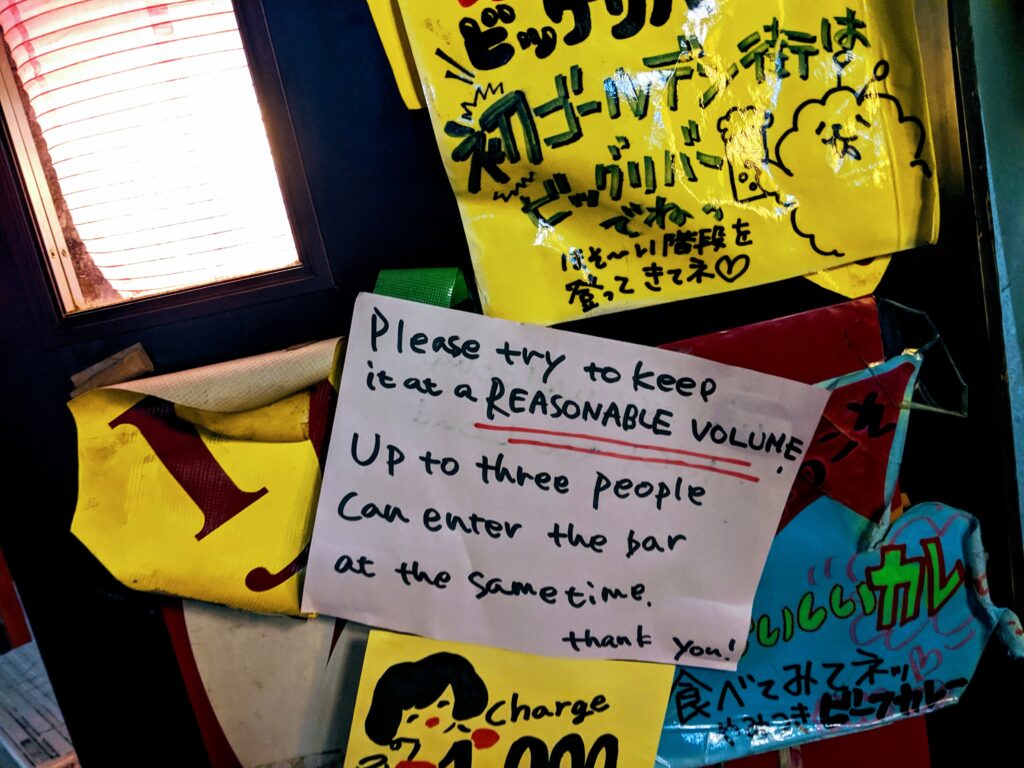


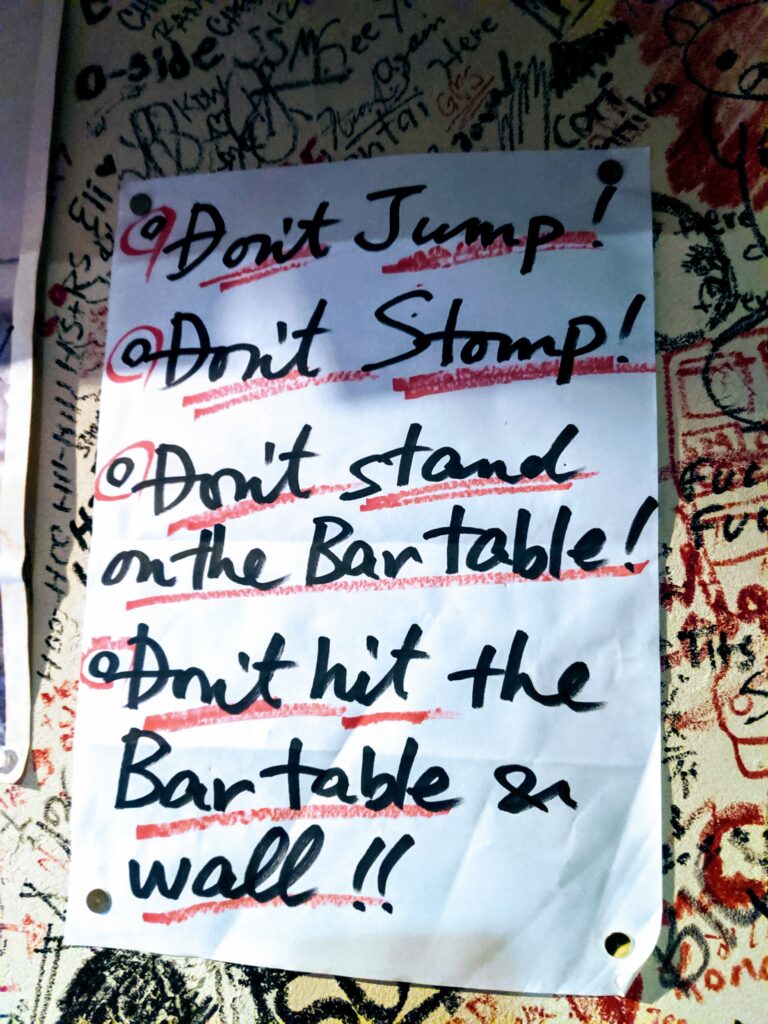

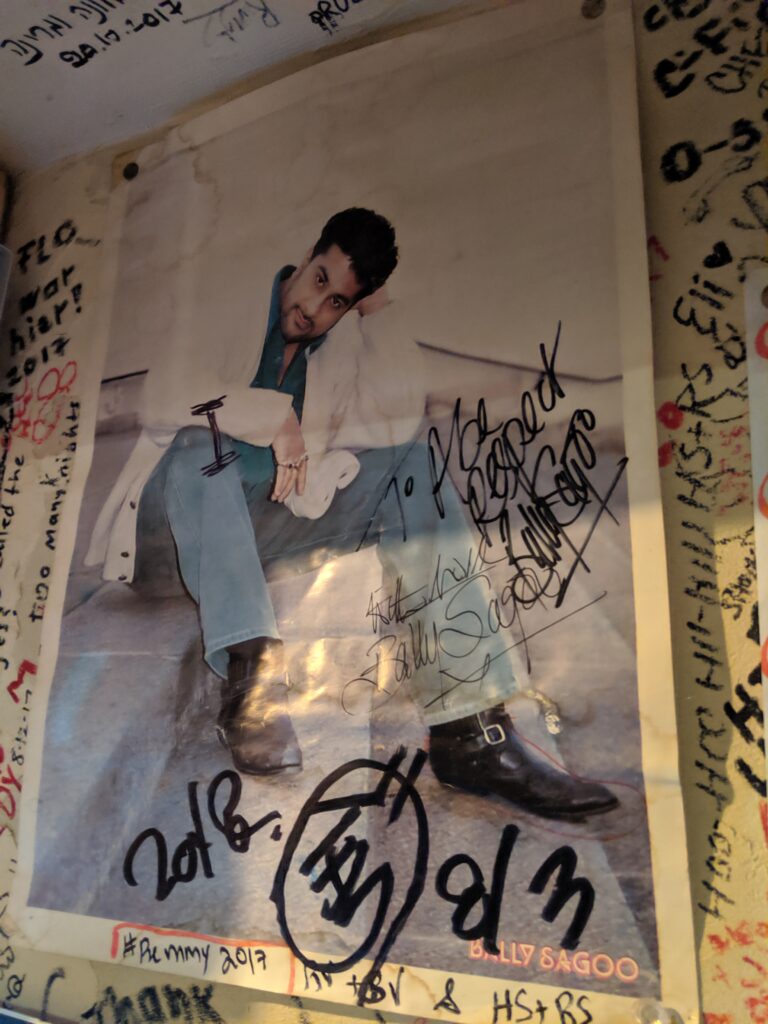
Bar Champion is a really fun Karaoke bar that also has “one coin” 500 yen drinks. If you enjoy drinking, Karaoke, being smushed into dark, noisy enclosed spaces with strangers, this is definitely the right place for you. And the best part is, you don’t even have to be a good singer. I felt like I was listening to a bunch of cats being strangled in an alleyway, but it was great! We may even have contributed to making ears bleed!
Day 5: TeamLab Borderless, Shibuya crossing, Akihabara & Piss Alley!
TeamLab Borderless is unlike any museum I have been to! If you are visiting Tokyo, you just simply MUST go here! It is a magical place full of colour, light and sound. The art wanders freely between rooms and interacts with your body! Do not confuse this with the TeamLab Planets which is a completely different museum!
To get to TeamLab Borderless I suggest you check google than rely on my blog! Please don’t roll your eyes at me, lazy people are the ones that change the world…like the person who invented edible cupcake wrappers. I just wanted some cake but now I have to take off paper? Life is too short to be wasted in taking off cupcake wrappers (and also giving you directions to get to the museum that you can get from google).
Rather than go into details I am just going to shove some photos in your face and believe me you, it is way better than it looks in the pictures. Here are a bunch of photos from inside the museum with mostly unhelpful captions:



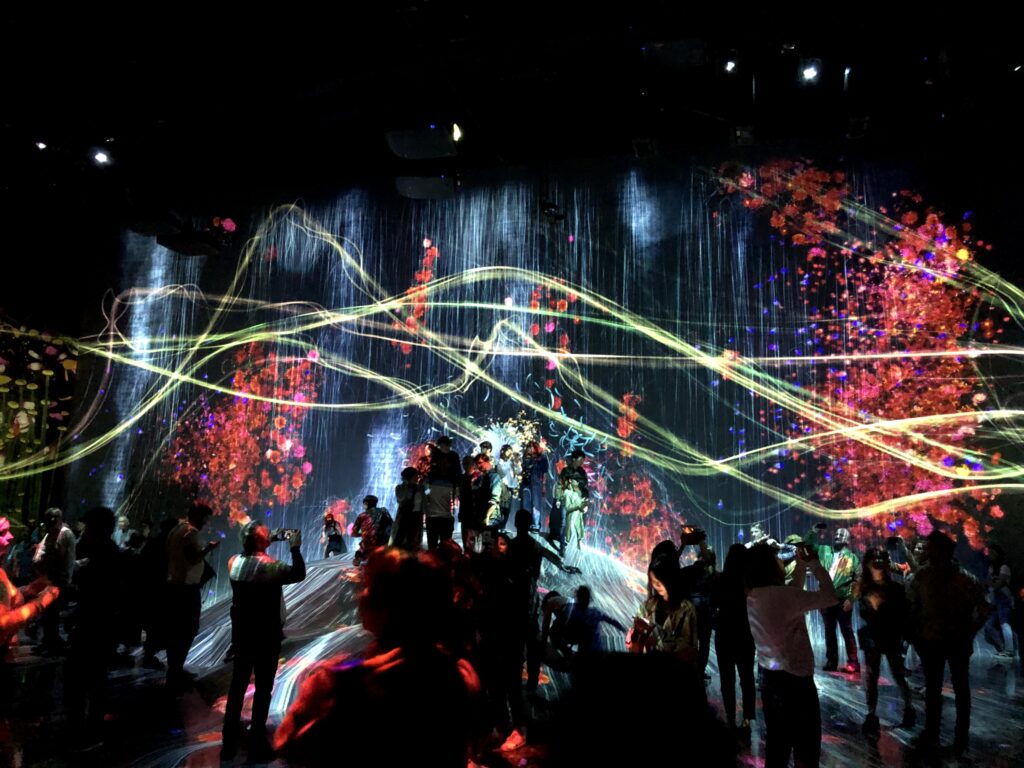
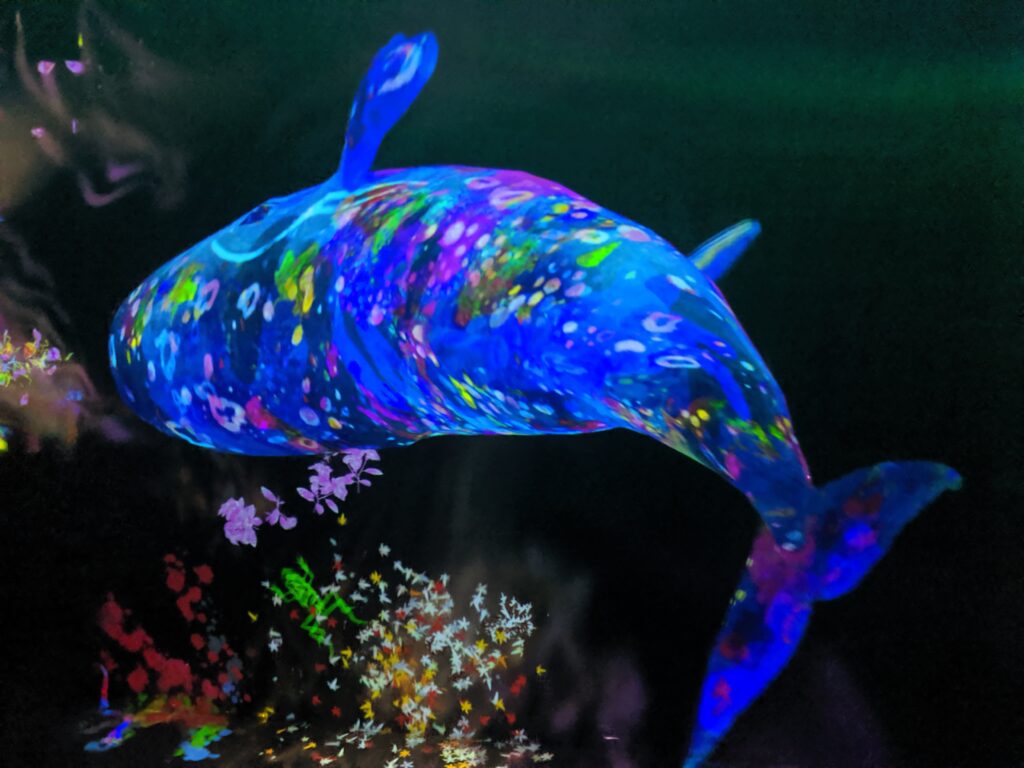
Also if you like tea (or even if you don’t), you should visit the En Tea house. They serve you tea (DUH!), the tea in the bowl becomes an infinite world in which the flowers continue to bloom and as soon as you pick the bowl up, the petals start to scatter. Sip on the tea while also staring at the art inside your cup and be blown away! It is an amazing experience!

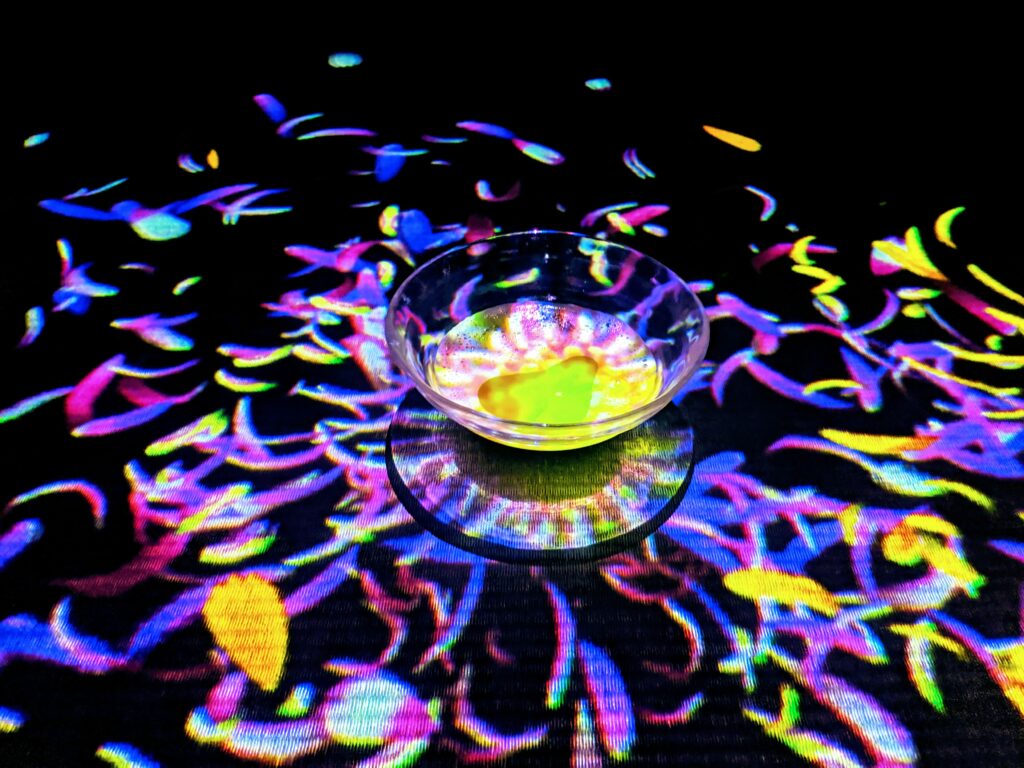
Shibuya Crossing:
From the museum we went to the Shibuya crossing. It is the busiest intersection in the world and gets up to 390,000 pedestrians per day!! If you know me, you must already know my dislike for overly crowded places, but I’ll have you know even I enjoyed just walking amongst the crowd. We also looked at the pedestrians move like a swarm of insects(truly remarkable) from the Starbucks on the opposite side of the road, while sipping our coffee. It amazes me, even with that volume of people, all of them get off the street in a timely manner so as not to obstruct traffic (How Japanese!)

Akhihabara:
Akhihabara is Tokyo’s prime location for Anime and Manga, videogames and electronics. Ever since Japanese pop culture is gaining so much popularity all over the world, Akhiharaba gets a lot of tourists! The whole district is covered in flashing lights, wildly dressed young people, and animated advertisements. The streets had a lot of pachinko parlors and maid cafes. If you are not familiar with Maid cafes, Maid cafes are cafes where waitresses are dressed up in maid costumes, and customers are treated as masters! It’s this strange sexual but not sexual thing. Just like any cafe, you can go here and order food and drinks. We thought it was kind of strange, but they exist because they sell. It feels like a sort of escapism for the average Japanese man, where they can just go in without being judged on their place in the society and be treated like a king! This may be one of the least weirdest weird things we saw here.
I think it’s fair to say that no other country does weird better than Japan. Japan is weird, but so am I, so it worked out shockingly well! Also, since you are in Japan, I believe you should embrace the weirdness and just go with it. I am sure every country has things that are considered weird everywhere else…for eg, in India, it is quite common to honk even at red lights! Red lights in India must only turn green when intensity of honks is beyond ears shattering decibels! Be prepared to be approached by maids standing outside the cafes trying to lure you in. We didn’t go to any, because they seemed like a tourist trap! There are also other services depending on each cafe, such as waitresses singing and dancing or taking a photo with you.
We also explored Don Quixote, a huge discount store spread over several stories, which sells everything, from sweets, cosplay costumes to second hand Louis Vuitton bags. I got so absorbed by all the items I found around, I lost track of time..it is a good place to buy souvenirs.
The whole district of Akihabara was the massive displays of anime and manga comics and characters which were predominant all around the district. There are also adult anime shops with disturbing hentai and sexual imagery! All in all I think it just depends on what you like to do, if you don’t have enough time I suggest you skip this.





Piss Alley:
After spending the evening in Akhihabara, we head to piss alley for food and drinks. Piss alley is right next to the Shinjuku station and definitely worth a visit. If you haven’t read my previous blog already, first of all WHYYYYY!!??!

And second of all, you should check out my blog about the Yakitori at Piss alley!



Other potentially fun things to do in Tokyo:
The robot restaurant for one, is very popular! It is loud, colourful and supposedly also very fun. It looks like a glitter factory exploded in the restaurant and if you like that sort of sensory overload and appreciate the sheer maniacal exuberance of it all or you fancy robots doing burlesque, you should definitely give it a go!


Also while you are in Shinjuku don’t forget to checkout the giant 80 ton Godzilla head that is placed on top of the Toho Cinemas!!


Tokyo also has a Disneyland that you can visit, which we decided to skip due to lack of time!
PS : So as it turns out, there was no “part 2” to a post…I TRICKED YOU!! MUAHAHAHHAHAA [insert best evil homicidal laugh]. But congratulations readers, you have made it to the end of this reallllly long blog post [HUZZZAAAHHH!]… Is there a medal for this? If so, please buy yourselves one…because you deserve it. Not the bullshit participation medal. No one wants that. That’s for losers…not saying that you are a loser…I should really stop writing now …
PPS : Also if there are some amazingly weird things that we missed out on in Tokyo, please let me know in the comments! 🤝
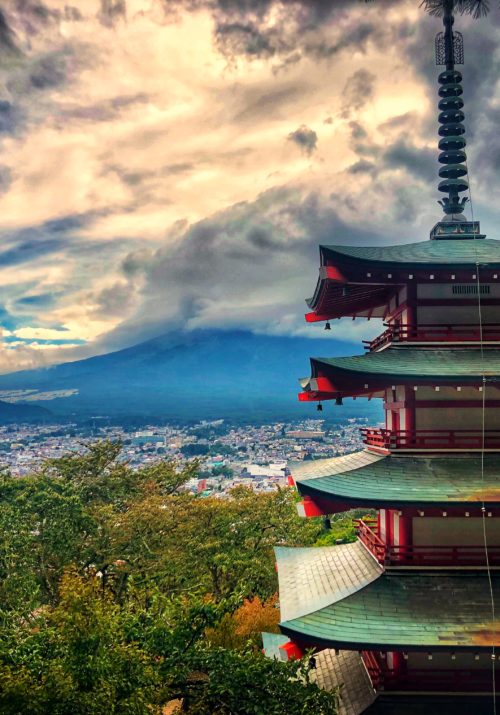



Leave a Reply